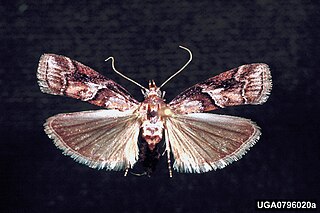
Dioryctria sylvestrella, the new pine knot-horn or maritime pine borer, is a moth of the family Pyralidae. It is found in Europe, parts of Asia and North Africa. The adult is a small mottled brown and white insect with a wingspan of 28 to 35 mm. The moth flies in a single generation from June to October and is a pest of maritime pine and several other species of pine, on which the caterpillars feed.

Tebenna gnaphaliella, the everlasting tebenna moth, is a moth of the family Choreutidae. It is found from Florida to California and north at least to New Hampshire.

Brenthia pavonacella, the peacock brenthia moth, is a moth of the family Choreutidae. It is found in North America, including Illinois, Maryland, Iowa, Oklahoma and South Carolina. It has also been recorded from Mexico.

Sciota subcaesiella, the locust leafroller moth, is a species of moth of the family Pyralidae. It is found in North America, including Maryland, New Jersey, Oklahoma, Iowa, North Carolina, South Carolina, Georgia, Alabama, Mississippi, Maine, New Hampshire, New York, Massachusetts, Pennsylvania, the District of Columbia, Virginia, Tennessee, Illinois, Missouri, Arkansas, Nova Scotia and Ontario.

Dioryctria zimmermani, the Zimmerman pine moth, is a moth of the family Pyralidae. It is found from southern Canada and the north-eastern and Great Lakes areas of the United States. There is a disjunct population in eastern Nebraska.

Dioryctria clarioralis, the blister coneworm moth, is a moth of the family Pyralidae. It is found in the eastern United States, including Florida, New Jersey and Virginia.

Evergestis rimosalis, commonly known as the cross-striped cabbageworm, is a species of moth in the family Crambidae. It is found in most of the eastern United States.

Diaphania hyalinata, the melonworm moth, is a moth of the family Crambidae. It is found in eastern North America, south to Central and South America, including Suriname and the Caribbean.

Paraclemensia acerifoliella, the maple leafcutter moth, is a moth of the family Incurvariidae. It is found from south-eastern Canada and the north-eastern United States, south to the tip of the Appalachian Mountains in western North Carolina and possibly north-western Georgia.
Arivaca ostreella is a species of snout moth described by Émile Louis Ragonot in 1887. It is found in the US from southern Arizona through New Mexico to Texas.

Retinia arizonensis, the pinyon pitch nodule moth, is a species of moth of the family Tortricidae. It is found in North America.

Pococera robustella, the pine webworm moth, is a species of moth of the family Pyralidae. It is found in southern Canada and the eastern United States from Minnesota to New England and south to Florida.

Dioryctria auranticella, the ponderosa pineconeworm moth, is a moth of the family Pyralidae. The species was first described by Augustus Radcliffe Grote in 1883. It is found in western North America from southern British Columbia south to California and Arizona, east to South Dakota and New Mexico.

Dioryctria resinosella, the red pine shoot moth, is a species of moth of the family Pyralidae described by Akira Mutuura in 1982. It is found in Ontario and the northern United States.

Dioryctria ebeli, the south coastal coneworm moth, is a species of moth of the family Pyralidae. It is found in the US states of Florida, the southern parts of South Carolina, Georgia, Alabama, Massachusetts, and south-eastern Louisiana.

Dioryctria amatella, the southern pineconeworm moth, is a species of moth of the family Pyralidae. It is found in the south-eastern United States, from Maryland south to Florida and west into Texas.

Dioryctria reniculelloides, the spruce coneworm, is a moth of the family Pyralidae. The species was first described by Akira Mutuura and Eugene G. Munroe in 1973. It is found from Nova Scotia to Alaska, south in the east to New York, and south in the west to California and New Mexico. It was recorded from China in 2009. Occasionally abundant, often in conjunction with epidemics of the spruce budworm, the spruce coneworm occurs through most or all of the range of spruce in North America, feeding on new foliage and cones of spruce, and often balsam fir. When abundant, it can be a serious pest "particularly on white spruce".

Dioryctria disclusa, the webbing coneworm or rusty pine cone moth, is a species of moth of the family Pyralidae. It is found in North America from New Brunswick to Florida, west to Texas and north to Manitoba.

Condylolomia participalis, the drab condylolomia moth, is a species of snout moth in the genus Condylolomia. It was described by Augustus Radcliffe Grote in 1873. It is found in eastern North America, from southern Quebec to North Carolina, west to Nebraska and Minnesota.
Dioryctria baumhoferi is a species of snout moth in the genus Dioryctria. It was described by Carl Heinrich in 1956, and is known from the US states of Arizona and California.





















